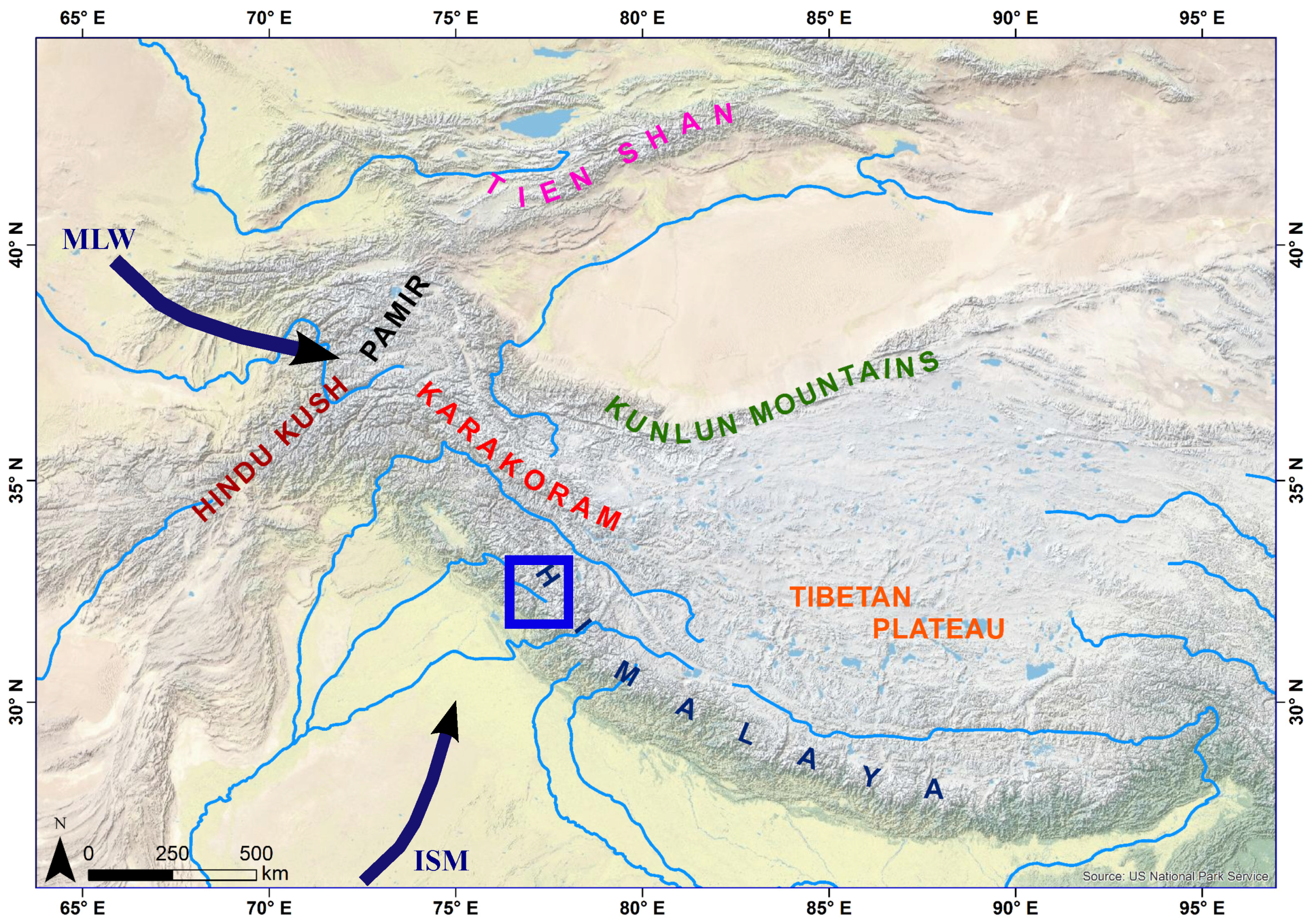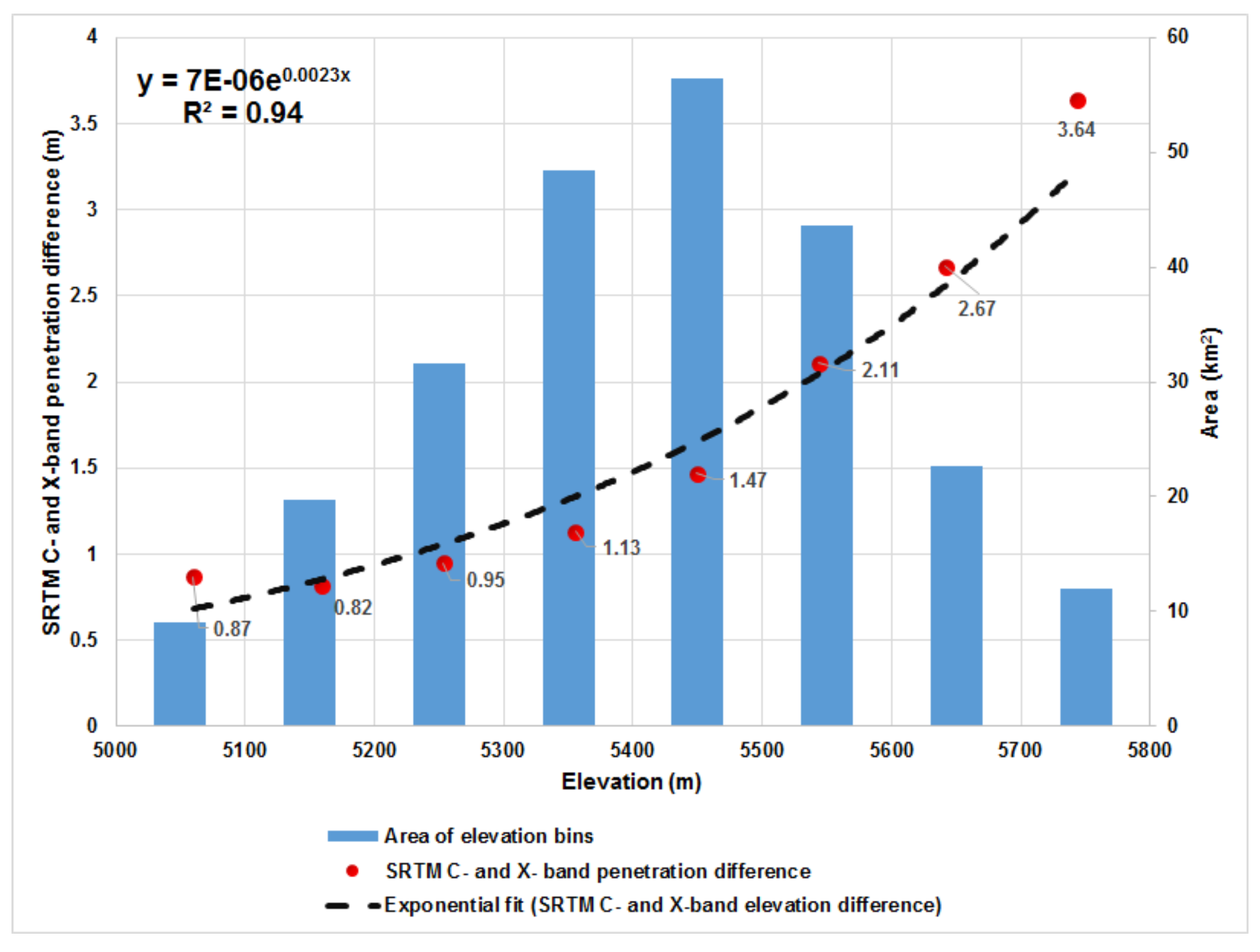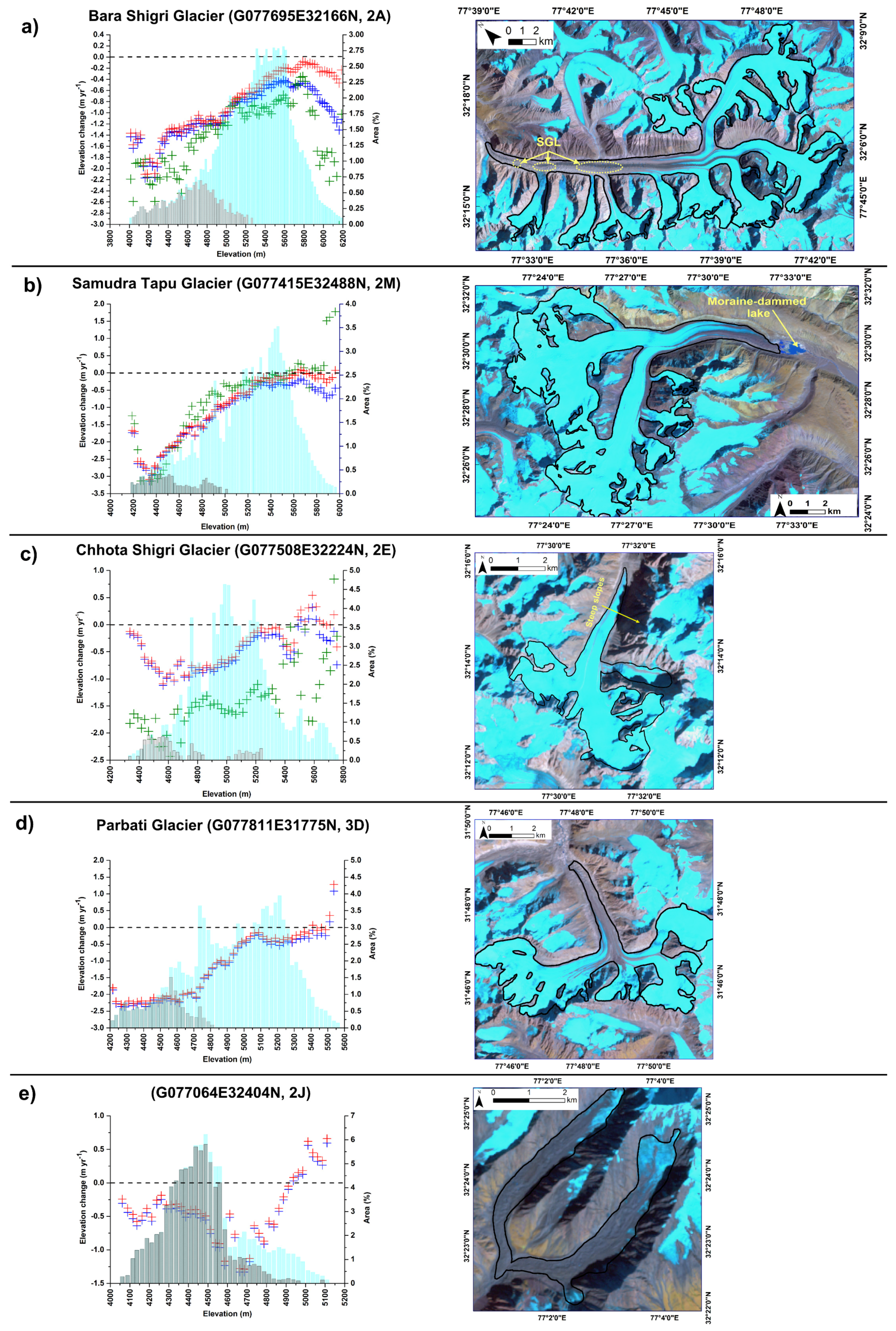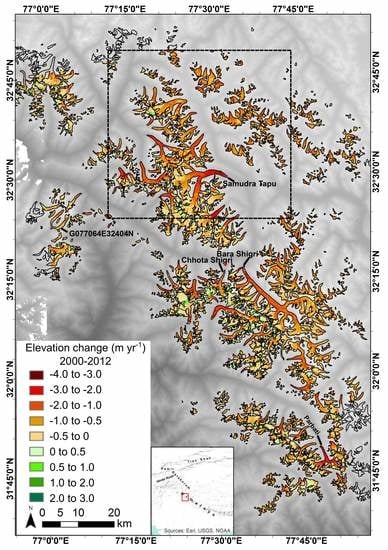Elevation Change Rates of Glaciers in the Lahaul-Spiti (Western Himalaya, India) during 2000–2012 and 2012–2013
Abstract
:1. Introduction
- to provide spatially detailed elevation change estimates of glaciers in the Lahaul Spiti region based on X-/C-band synthetic aperture radar interferometry;
- to assess the potential of the TanDEM-X (TerraSAR-X add-on for DEM Measurements) mission (X-band) to measure glacier elevation changes in one year time scale;
- to estimate the impact of X-/C-band penetration into glaciers and its implications for region-wide surface elevation change estimates;
- to investigate several glacier properties (e.g., supraglacial debris coverage, supraglacial lakes, ponds, ice cliffs etc.) to explain glacier elevation change.
2. Study Area
3. Data
4. Methods
4.1. Elevation Change
4.1.1. Interferometric Processing
4.1.2. Mosaicking
4.1.3. SRTM C- and X-Band Penetration Difference
4.2. Geodetic Mass Balance
4.3. Uncertainty Estimate
5. Results
5.1. SRTM C- and X-Band Radar Penetration Differences
5.2. Mean Glacier Surface Elevation Changes during 2000–2012
5.3. Geodetic Mass Balance during 2000–2012
5.4. Spatial Elevation Change Patterns on Glacier Scale during 2000–2012
5.5. Elevation and Mass Changes for Selected Glaciers between 2000–2012 and 2012–2013
6. Discussion
6.1. Radar Penetration Bias
6.2. Geodetic Mass Balance Estimates
6.3. Heterogeneous Elevation Change Patterns and Possible Reasons
7. Conclusions and Outlook
Supplementary Materials
Acknowledgments
Author Contributions
Conflicts of Interest
References
- Kääb, A.; Berthier, E.; Nuth, C.; Gardelle, J.; Arnaud, Y. Contrasting patterns of early twenty-first-century glacier mass change in the Himalayas. Nature 2012, 488, 495–498. [Google Scholar] [CrossRef] [PubMed]
- Azam, M.F.; Wagnon, P.; Vincent, C.; Ramanathan, A.; Favier, V.; Mandal, A.; Pottakkal, J.G. Processes governing the mass balance of Chhota Shigri Glacier (western Himalaya, India) assessed by point-scale surface energy balance measurements. Cryosphere 2014, 8, 2195–2217. [Google Scholar] [CrossRef]
- Singh, S.; Kumar, R.; Bhardwaj, A.; Sam, L.; Shekhar, M.; Singh, A.; Kumar, R.; Gupta, A. Changing climate and glacio-hydrology in Indian Himalayan Region: A review. Wiley Interdiscip. Rev. Clim. Chang. 2016, 7, 393–410. [Google Scholar]
- Wiltshire, A.J. Climate change implications for the glaciers of the Hindu Kush, Karakoram and Himalayan region. Cryosphere 2014, 8, 941–958. [Google Scholar] [CrossRef]
- Vincent, C.; Ramanathan, A.; Wagnon, P.; Dobhal, D.P.; Linda, A.; Berthier, E.; Sharma, P.; Arnaud, Y.; Azam, M.F.; Jose, P.G.; et al. Balanced conditions or slight mass gain of glaciers in the Lahaul and Spiti region (northern India, Himalaya) during the nineties preceded recent mass loss. Cryosphere 2013, 7, 569–582. [Google Scholar] [CrossRef]
- Anderson, L.S.; Anderson, R.S. Modeling debris-covered glaciers: response to steady debris deposition. Cryosphere 2016, 10, 1105–1124. [Google Scholar] [CrossRef]
- Ragettli, S.; Bolch, T.; Pellicciotti, F. Heterogeneous glacier thinning patterns over the last 40 years in Langtang Himal, Nepal. Cryosphere 2016, 10, 2075–2097. [Google Scholar] [CrossRef]
- Vincent, C.; Wagnon, P.; Shea, J.M.; Immerzel, W.W.; Kraaijenbrink, P.D.A.; Shrestha, D.; Soruco, A.; Arnaud, Y.; Brun, F.; Berthier, E.; et al. Reduced melt on debris-covered glaciers: Investigations from Changri Nup Glacier, Nepal. Cryosphere 2016, 10, 1845–1858. [Google Scholar] [CrossRef]
- Sakai, A.; Takeuchi, N.; Fujita, K.; Nakawo, M. Role of supraglacial ponds in the ablation process of a debris-covered glacier in the Nepal Himalayas. In Debris-Covered Glaciers; IAHS Publications: Wallingford, UK, 2000; Volume 265, pp. 119–130. [Google Scholar]
- Reid, T.; Brock, B. Assessing ice-cliff backwasting and its contribution to total ablation of debris-covered Miage glacier, Mont Blanc massif, Italy. J. Glaciol. 2014, 60, 3–13. [Google Scholar] [CrossRef]
- Benn, D.I.; Bolch, T.; Hands, K.; Gulley, J.; Luckman, A.; Nicholson, L.I.; Quincey, D.; Thompson, S.; Toumi, R.; Wiseman, S. Response of debris-covered glaciers in the Mount Everest region to recent warming, and implications for outburst flood hazards. Earth-Sci. Rev. 2012, 114, 156–174. [Google Scholar] [CrossRef]
- Dobhal, D.; Mehta, M.; Srivastava, D. Influence of debris cover on terminus retreat and mass changes of Chorabari Glacier, Garhwal region, central Himalaya, India. J. Glaciol. 2013, 59, 961–971. [Google Scholar] [CrossRef]
- Schauwecker, S.; Rohrer, M.; Huggel, C.; Kulkarni, A.; Ramanathan, A.L.; Salzmann, N.; Stoffel, M.; Brock, B. Remotely sensed debris thickness mapping of Bara Shigri Glacier, Indian Himalaya. J. Glaciol. 2015, 61, 675–688. [Google Scholar] [CrossRef]
- Gardelle, J.; Berthier, E.; Arnaud, Y.; Kääb, A. Region-wide glacier mass balances over the Pamir-Karakoram- Himalaya during 1999–2011. Cryosphere 2013, 7, 1263–1286. [Google Scholar] [CrossRef]
- Dehecq, A.; Millan, R.; Berthier, E.; Gourmelen, N.; Trouvé, E.; Vionnet, V. Elevation changes inferred from TanDEM-X data over the Mont-Blanc area: Impact of the X-band interferometric Bias. IEEE J. Sel. Top. Appl. Earth Observ. Remote Sens. 2016, 9, 3870–3882. [Google Scholar] [CrossRef]
- Rott, H.; Yueh, S.H.; Cline, D.W.; Duguay, C.; Essery, R.; Haas, C.; Heliere, F.; Kern, M.; Macelloni, G.; Malnes, E.; et al. Cold Regions hydrology high-resolution observatory for snow and cold land processes. Proc. IEEE 2010, 98, 752–765. [Google Scholar] [CrossRef]
- Wagnon, P.; Linda, A.; Arnaud, Y.; Kumar, R.; Sharma, P.; Vincent, C.; Pottakkal, J.G.; Berthier, E.; Ramanathan, A.; Hasnain, S.I.; et al. Four years of mass balance on Chhota Shigri Glacier, Himachal Pradesh, India, a new benchmark glacier in the western Himalaya. J. Glaciol. 2007, 53, 603–611. [Google Scholar] [CrossRef]
- Azam, M.F.; Ramanathan, A.; Wagnon, P.; Vincent, C.; Linda, A.; Berthier, E.; Sharma, P.; Mandal, A.; Angchuk, T.; Singh, V.B.; et al. Meteorological conditions, seasonal and annual mass balances of Chhota Shigri Glacier, western Himalaya, India. Ann. Glaciol. 2016, 57, 328–338. [Google Scholar] [CrossRef]
- Azam, M.F.; Wagnon, P.; Vincent, C.; Ramanathan, A.; Linda, A.; Singh, V.B. Reconstruction of the annual mass balance of Chhota Shigri glacier, Western Himalaya, India, since 1969. Ann. Glaciol. 2014, 55, 69–80. [Google Scholar] [CrossRef]
- Hoffmann, J.; Walter, D. How Complementary are SRTM-X and C-Band digital elevation models? Photogramm. Eng. Remote Sens. 2006, 72, 261–268. [Google Scholar] [CrossRef]
- Krieger, G.; Moreira, A.; Fiedler, H.; Hajnsek, I.; Werner, M.; Younis, M.; Zink, M. TanDEM-X: A satellite formation for high-resolution SAR interferometry. IEEE Trans. Geosci. Remote Sens. 2007, 45, 3317–3341. [Google Scholar] [CrossRef]
- Arendt, A.; Bliss, A.; Bolch, T.; Cogley, J.G.; Gardner, A.S.; Hagen, J.O.; Hock, R.; Huss, M.; Kaser, G.; Kienholz, C.; et al. Randolph Glacier Inventory—A Dataset of Global Glacier Outlines: Version 5.0; Technical Report; Global Land Ice Measurements from Space: Boulder, CO, USA, 2015. [Google Scholar]
- Nuimura, T.; Sakai, A.; Taniguchi, K.; Nagai, H.; Lamsal, D.; Tsutaki, S.; Kozawa, A.; Hoshina, Y.; Takenaka, S.; Omiya, S.; et al. The GAMDAM glacier inventory: A quality-controlled inventory of Asian glaciers. Cryosphere 2015, 9, 849–864. [Google Scholar] [CrossRef]
- Rankl, M.; Braun, M. Glacier elevation and mass changes over the central Karakoram region estimated from TanDEM-X and SRTM/X-SAR digital elevation models. Ann. Glaciol. 2016, 51, 273–281. [Google Scholar] [CrossRef]
- Rosen, P.A.; Werner, C.W.; Hiramatsu, A. Two-dimensional phase unwrapping of SAR interferograms by charge connection through neutral trees. In Proceedings of the Geoscience and Remote Sensing Symposium (IGARSS), Pasadena, CA, USA, 8–12 August 1994.
- Costantini, M. A novel phase unwrapping method based on network programming. IEEE Trans. Geosci. Remote Sens. 1998, 36, 813–821. [Google Scholar] [CrossRef]
- Fritz, T.; Rossi, C.; Yague-Martinez, N.; Rodriguez-Gonzalez, F.; Lachaise, M.; Breit, H. Interferometric processing of TanDEM-X data. In Proceedings of the Geoscience and Remote Sensing Symposium (IGARSS), Vancouver, BC, Canada, 24–29 July 2011.
- Gardelle, J.; Berthier, E.; Arnaud, Y. Impact of resolution and radar penetration on glacier elevation changes computed from DEM differencing. J. Glaciol. 2012, 58, 419–422. [Google Scholar] [CrossRef]
- Huss, M. Density assumptions for converting geodetic glacier volume change to mass change. Cryosphere 2013, 7, 877–887. [Google Scholar] [CrossRef]
- Guo, Z.; Wang, N.; Kehrwald, N.M.; Mao, R.; Wu, H.; Wu, Y.; Jiang, X. Temporal and spatial changes in Western Himalayan firn line altitudes from 1998 to 2009. Glob. Planet. Chang. 2014, 118, 97–105. [Google Scholar] [CrossRef]
- Dormann, C.F.; McPherson, J.M.; Araújo, M.B.; Bivand, R.; Bolliger, J.; Carl, G.; Davies, R.G.; Hirzel, A.; Jetz, W.; Kissling, W.D.; et al. Methods to account for spatial autocorrelation in the analysis of species distributional data: A review. Ecography 2007, 30, 609–628. [Google Scholar] [CrossRef]
- Höhle, J.; Höhle, M. Accuracy assessment of digital elevation models by means of robust statistical methods. ISPRS J. Photogramm. Remote Sens. 2009, 64, 398–406. [Google Scholar] [CrossRef]
- Holzer, N.; Vijay, S.; Yao, T.; Xu, B.; Buchroithner, M.; Bolch, T. Four decades of glacier variations at Muztagh Ata (eastern Pamir): A multi-sensor study including Hexagon KH-9 and Pléiades data. Cryosphere 2015, 9, 2071–2088. [Google Scholar] [CrossRef]
- Berthier, E.; Cabot, V.; Vincent, C.; Six, D. Decadal region-wide and glacier-wide mass balances derived from multi-temporal ASTER satellite digital elevation models. Validation over the Mont-Blanc area. Front. Earth Sci. 2016, 4, 63. [Google Scholar] [CrossRef]
- Mätzler, C. Applications of the interaction of microwaves with the natural snow cover. Remote Sens. Rev. 1987, 2, 259–387. [Google Scholar] [CrossRef]
- Müller, K.; Hamran, S.E.; Sinisalo, A.; Hagen, J.O. Phase center of L- band radar in polar snow and ice. IEEE Trans. Geosci. Remote Sens. 2011, 49, 4572–4579. [Google Scholar] [CrossRef]
- Rott, H.; Floricioiu, D.; Wuite, J.; Scheiblauer, S.; Nagler, T.; Kern, M. Mass changes of outlet glaciers along the Nordensjköld Coast, northern Antarctic Peninsula, based on TanDEM-X satellite measurements. Geophys. Res. Lett. 2014, 41, 8123–8129. [Google Scholar] [CrossRef]
- Seehaus, T.; Marinsek, S.; Helm, V.; Skvarca, P.; Braun, M. Changes in ice dynamics, elevation and mass discharge of Dinsmoor-Bombardier-Edgeworth glacier system, Antarctic Peninsula. Earth Planet. Sci. Lett. 2015, 427, 125–135. [Google Scholar] [CrossRef]
- Nuimura, T.; Fujita, K.; Yamaguchi, S.; Sharma, R.R. Elevation changes of glaciers revealed by multitemporal digital elevation models calibrated by GPS survey in the Khumbu region, Nepal Himalaya, 1992–2008. J. Glaciol. 2012, 58, 648–656. [Google Scholar] [CrossRef]
- Basnett, S.; Kulkarni, A.V.; Bolch, T. The influence of debris cover and glacial lakes on the recession of glaciers in Sikkim Himalaya, India. J. Glaciol. 2013, 59, 1035–1046. [Google Scholar] [CrossRef]
- Sakai, A.; Nakawo, M.; Fujita, K. Distribution characteristics and energy balance of ice cliffs on debris-covered laciers, Nepal Himalaya. Arct. Antarct. Alp. Res. 2002, 34, 12–19. [Google Scholar] [CrossRef]







| S.No. | Date (Day Month Year) | Time (HH:MM:SS) | Orbit | B (m) | HoA (m) | Incidence Angle () | Phase Unwrapping |
|---|---|---|---|---|---|---|---|
| 1 | 29 January 2012 | 12:45:46 | Ascending | 82.31 | −75.73 | 38.52 | BC |
| 2 | 29 January 2012 | 12:45:53 | Ascending | 82.53 | −75.74 | 38.54 | BC |
| 3 | 9 February 2012 | 12:45:39 | Ascending | 83.98 | −68.76 | 36.29 | MCF |
| 4 | 9 February 2012 | 12:45:46 | Ascending | 84.21 | −68.30 | 36.22 | BC |
| 5 | 9 February 2012 | 12:45:53 | Ascending | 84.37 | −68.26 | 36.28 | BC |
| 6 | 20 February 2012 | 12:45:52 | Ascending | 88.67 | 59.14 | 33.69 | MCF |
| 7 | 26 January 2013 | 12:45:52 | Ascending | 130.09 | 45.10 | 37.09 | MCF |
| 8 | 26 January 2013 | 12:45:58 | Ascending | 130.24 | 45.04 | 37.08 | MCF |
| Individual Glaciers | Entire Region | |||||
|---|---|---|---|---|---|---|
| Characteristics | Samudra Tapu | Bara Shigri | Chhota Shigri | Parbati | G077064E32404N | Lahaul-Spiti |
| Area (km) | 80.76 | 112.44 | 13.52 | 23.83 | 8.24 | 1796.33 |
| Measured area (%) | 98.8 | 98.4 | 97.1 | 98.4 | 98.2 | 95.3 |
| Debris covered | 8.23% | 18.43% | 6.06% | 16.30% | 78.20% | 21.91% |
| Terminus | lake-term. | land-term. | land-term. | land-term. | land-term. | X |
| Mean slope () | 12.3 | 12.8 | 19.2 | 15.7 | 13.8 | X |
| Orientation | E | NW | N | N | SW | X |
| (2000–2012) | ||||||
| Uncorrected dh/dt (m yr) | −0.68 ± 0.37 | −0.62 ± 0.37 | −0.47 ± 0.40 | −0.92 ± 0.38 | −0.52 ± 0.36 | −0.52 ± 0.43 |
| Corrected dh/dt (m yr) | −0.81 ± 0.37 | −0.78 ± 0.37 | −0.55 ± 0.40 | −0.99 ± 0.38 | −0.58 ± 0.36 | −0.65 ± 0.43 |
| Volume change (10 km yr) | −64.60 ± 30.50 | −86.26 ± 42.21 | −7.22 ± 5.32 | −23.22 ± 9.34 | −4.69 ± 2.96 | −1112.85 ± 760.12 |
| (Case A) | ||||||
| Geodetic mass balance (m w.e. yr) | −0.72 ± 0.33 | −0.70 ± 0.33 | −0.49 ± 0.36 | −0.89 ± 0.34 | −0.52 ± 0.32 | −0.58 ± 0.39 |
| (Case B) | ||||||
| Geodetic mass balance (m w.e. yr) | −0.69 ± 0.31 | −0.66 ± 0.31 | −0.46 ± 0.34 | −0.85 ± 0.32 | −0.49 ± 0.31 | −0.53 ± 0.37 |
| (Case C) | ||||||
| Geodetic mass balance (m w.e. yr) | −0.68 ± 0.28 | −0.62 ± 0.28 | −0.48 ± 0.30 | −0.89 ± 0.29 | −0.52 ± 0.27 | −0.52 ± 0.32 |
| (2012–2013) | ||||||
| dh/dt (m yr) | −0.11 ± 1.43 | −0.61 ± 1.47 | −1.00 ± 1.51 | X | X | X |
| Volume change (10 km yr) | −8.77 ± 114.01 | −67.45 ± 162.57 | −13.13 ± 19.89 | X | X | X |
| (Case A) | ||||||
| Geodetic mass balance (m w.e. yr) | −0.10 ± 1.29 | −0.55 ± 1.32 | −0.91 ± 1.36 | X | X | X |
| (Case B) | ||||||
| Geodetic mass balance (m w.e. yr) | −0.09 ± 1.22 | −0.51 ± 1.25 | −0.86 ± 1.28 | X | X | X |
| (Case C) | ||||||
| Geodetic mass balance (m w.e. yr) | −0.15 ± 1.07 | −0.47 ± 1.10 | −0.89 ± 1.13 | X | X | X |
© 2016 by the authors; licensee MDPI, Basel, Switzerland. This article is an open access article distributed under the terms and conditions of the Creative Commons Attribution (CC-BY) license (http://creativecommons.org/licenses/by/4.0/).
Share and Cite
Vijay, S.; Braun, M. Elevation Change Rates of Glaciers in the Lahaul-Spiti (Western Himalaya, India) during 2000–2012 and 2012–2013. Remote Sens. 2016, 8, 1038. https://doi.org/10.3390/rs8121038
Vijay S, Braun M. Elevation Change Rates of Glaciers in the Lahaul-Spiti (Western Himalaya, India) during 2000–2012 and 2012–2013. Remote Sensing. 2016; 8(12):1038. https://doi.org/10.3390/rs8121038
Chicago/Turabian StyleVijay, Saurabh, and Matthias Braun. 2016. "Elevation Change Rates of Glaciers in the Lahaul-Spiti (Western Himalaya, India) during 2000–2012 and 2012–2013" Remote Sensing 8, no. 12: 1038. https://doi.org/10.3390/rs8121038
APA StyleVijay, S., & Braun, M. (2016). Elevation Change Rates of Glaciers in the Lahaul-Spiti (Western Himalaya, India) during 2000–2012 and 2012–2013. Remote Sensing, 8(12), 1038. https://doi.org/10.3390/rs8121038







